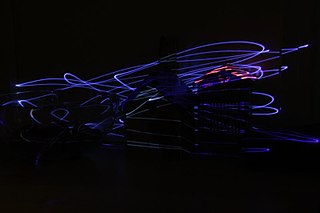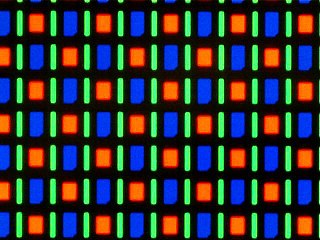Related Research Articles

Organic electronics is a field of materials science concerning the design, synthesis, characterization, and application of organic molecules or polymers that show desirable electronic properties such as conductivity. Unlike conventional inorganic conductors and semiconductors, organic electronic materials are constructed from organic (carbon-based) molecules or polymers using synthetic strategies developed in the context of organic chemistry and polymer chemistry.

Photonics is a branch of optics that involves the application of generation, detection, and manipulation of light in form of photons through emission, transmission, modulation, signal processing, switching, amplification, and sensing. Photonics is closely related to quantum electronics, where quantum electronics deals with the theoretical part of it while photonics deal with its engineering applications. Though covering all light's technical applications over the whole spectrum, most photonic applications are in the range of visible and near-infrared light. The term photonics developed as an outgrowth of the first practical semiconductor light emitters invented in the early 1960s and optical fibers developed in the 1970s.

An organic light-emitting diode (OLED), also known as organic electroluminescentdiode, is a light-emitting diode (LED) in which the emissive electroluminescent layer is a film of organic compound that emits light in response to an electric current. This organic layer is situated between two electrodes; typically, at least one of these electrodes is transparent. OLEDs are used to create digital displays in devices such as television screens, computer monitors, and portable systems such as smartphones and handheld game consoles. A major area of research is the development of white OLED devices for use in solid-state lighting applications.

A flat-panel display (FPD) is an electronic display used to display visual content such as text or images. It is present in consumer, medical, transportation, and industrial equipment.

A flexible organic light-emitting diode (FOLED) is a type of organic light-emitting diode (OLED) incorporating a flexible plastic substrate on which the electroluminescent organic semiconductor is deposited. This enables the device to be bent or rolled while still operating. Currently the focus of research in industrial and academic groups, flexible OLEDs form one method of fabricating a rollable display.

A blue laser emits electromagnetic radiation with a wavelength between 400 and 500 nanometers, which the human eye sees in the visible spectrum as blue or violet.
Phosphorescent organic light-emitting diodes (PHOLED) are a type of organic light-emitting diode (OLED) that use the principle of phosphorescence to obtain higher internal efficiencies than fluorescent OLEDs. This technology is currently under development by many industrial and academic research groups.

eMagin Corporation is an American electronic components manufacturer based in Hopewell Junction, New York. eMagin specializes in organic light emitting diode (OLED) technology and manufactures micro OLED display used in virtual imaging products and other related products.

AMOLED is a type of OLED display device technology. OLED describes a specific type of thin-film-display technology in which organic compounds form the electroluminescent material, and active matrix refers to the technology behind the addressing of pixels.

Steven Van Slyke is an American chemist, best known for his co-invention of the Organic Light Emitting Diode (OLED) and his contributions to the commercial development of OLED displays. Van Slyke is currently the Chief Technology Officer at Kateeva, Inc. Prior to joining Kateeva, he held various positions at Eastman Kodak and was involved in all aspects of OLED technology, from basic materials development to implementation of full-color OLED display manufacturing.

A quantum dot display is a display device that uses quantum dots (QD), semiconductor nanocrystals which can produce pure monochromatic red, green, and blue light. Photo-emissive quantum dot particles are used in LCD backlights or display color filters. Quantum dots are excited by the blue light from the display panel to emit pure basic colors, which reduces light losses and color crosstalk in color filters, improving display brightness and color gamut. Light travels through QD layer film and traditional RGB filters made from color pigments, or through QD filters with red/green QD color converters and blue passthrough. Although the QD color filter technology is primarily used in LED-backlit LCDs, it is applicable to other display technologies which use color filters, such as blue/UV active-matrix organic light-emitting diode (AMOLED) or QNED/MicroLED display panels. LED-backlit LCDs are the main application of photo-emissive quantum dots, though blue OLED panels with QD color filters are being researched.

Ching Wan Tang is a Hong Kong–American physical chemist. He was inducted into the National Inventors Hall of Fame in 2018 for inventing OLED, and was awarded the 2011 Wolf Prize in Chemistry. Tang is the IAS Bank of East Asia Professor at the Hong Kong University of Science and Technology and previously served as the Doris Johns Cherry Professor at the University of Rochester.
An organic light-emitting transistor (OLET) is a form of transistor that emits light. These transistors have potential for digital displays and on-chip optical interconnects. OLET is a new light-emission concept, providing planar light sources that can be easily integrated in substrates like silicon, glass, and paper using standard microelectronic techniques.
Donal Donat Conor Bradley is the Vice President for Research at King Abdullah University of Science and Technology (KAUST), Saudi Arabia. From 2015 until 2019, he was head of the Mathematical, Physical and Life Sciences Division of the University of Oxford and a Professor of Engineering Science and Physics at Jesus College, Oxford. From 2006 to 2015, he was the Lee-Lucas Professor of Experimental Physics at Imperial College London. He was the founding director of the Centre for Plastic Electronics and served as vice-provost for research at the college.
Universal Display Corporation is a developer and manufacturer of organic light emitting diodes (OLED) technologies and materials as well as provider of services to the display and lighting industries. It is also an OLED research company. Founded in 1994, the company currently owns or has exclusive, co-exclusive or sole license rights with respect to more than 3,000 issued and pending patents worldwide for the commercialization of phosphorescent based OLEDs and also flexible, transparent and stacked OLEDs - for both display and lighting applications. Its phosphorescent OLED technologies and materials are licensed and supplied to companies such as Samsung, LG, AU Optronics CMEL, Pioneer, Panasonic Idemitsu OLED lighting and Konica Minolta.
Jeremy Henley Burroughes is a British physicist and engineer, known for his contributions to the development of organic electronics through his work on the science of semiconducting polymers and molecules and their application. He is the Chief Technology Officer of Cambridge Display Technology, a company specialising in the development of technologies based on polymer light-emitting diodes.
Mark E. Thompson is a Californian chemistry academic who has worked with OLEDs.
Thermally activated delayed fluorescence (TADF) is a process through which a molecular species in a non-emitting excited state can incorporate surrounding thermal energy to change states and only then undergo light emission. The TADF process involves an excited molecular species in a triplet state, which commonly has a forbidden transition to the ground state termed phosphorescence. By absorbing nearby thermal energy the triplet state can undergo reverse intersystem crossing (RISC) converting it to a singlet state, which can then de-excite to the ground state and emit light in a process termed fluorescence. Along with fluorescent and phosphorescent compounds, TADF compounds are one of the three main light-emitting materials used in organic light-emitting diodes (OLEDs).
Anna Köhler is a German physicist who is a Professor of Physics at the University of Bayreuth. Her research considers electronic processes in organic and organometallic molecules. She makes use of optical and electrical spectroscopy to better understand photo-physical processes. In 2020 she became the first woman to win the Max Born Medal and Prize.
Takatoshi Tsujimura is a Japanese scientist and businessman known for display and lighting commercialization.
References
- ↑ Center for Organic Photonics and Electronics Research (OPERA) at Kyushu University.
- ↑ ”Breakthrough in OLED Technology”, American Institute of Physics (March 2, 2015).
- ↑ Diaz, Fernando et al. “Photophysics of thermally activated delayed fluorescence molecules”, Methods and Applications In Fluorescence (2017).
- ↑ “Kyulux: Materializing the Future of OLEDs”
- ↑ Organic Electronics Editorial Board.
- ↑ "Chihaya Adachi". www.journals.elsevier.com. Retrieved 2017-06-25.
- ↑ "Paper list | Chihaya Adachi lab". www.cstf.kyushu-u.ac.jp. Retrieved 2017-06-26.
- ↑ "Patents | Chihaya Adachi lab". www.cstf.kyushu-u.ac.jp (in Japanese). Retrieved 2017-06-26.
- ↑ "Chihaya Adachi - Google Scholar Citations". scholar.google.com. Retrieved 2017-06-29.
- ↑ Uoyama, Hiroki; Goushi, Kenichi; Shizu, Katsuyuki; Nomura, Hiroko; Adachi, Chihaya (2012-12-13). "Highly efficient organic light-emitting diodes from delayed fluorescence". Nature. 492 (7428): 234–238. doi:10.1038/nature11687. hdl: 2324/25887 . ISSN 0028-0836. PMID 23235877. S2CID 4376505.
- ↑ (SID), Society for Information Display. "SID Salutes The 2014 Honors And Awards Recipients For Outstanding Achievements & Contributions To The Display Industry". www.prnewswire.com. Retrieved 2017-07-26.
- ↑ "Chihaya ADACHI | Kyushu University Global COE Program Science for Future Molecular Systems". www.chem.kyushu-u.ac.jp. Retrieved 2017-07-26.
- ↑ Analytics, Clarivate. "日本がリードする先端研究領域と、その領域で活躍する研究者を発表 - クラリベイト・アナリティクス". ip-science.thomsonreuters.jp (in Japanese). Archived from the original on 2017-07-24. Retrieved 2017-07-26.
- ↑ "Adachi's CV (for a Sun Yat-Sen University lecture)" (PDF).
- ↑ Kyulux (2023-04-28). "Kyushu University Professor Chihaya Adachi received the Purple Ribbon Medal". Kyulux. Retrieved 2023-08-22.